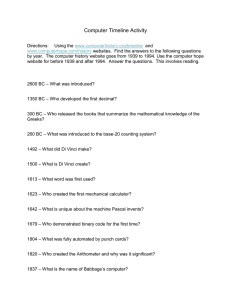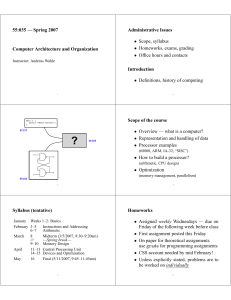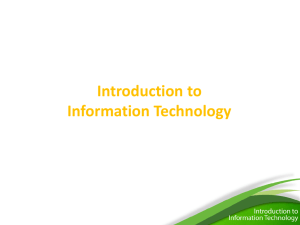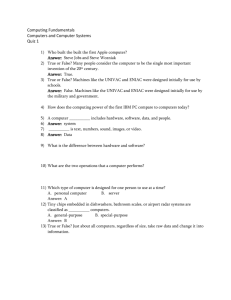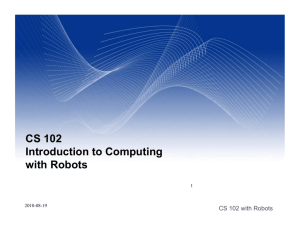1945 - 1956 Chapter 1: Advent of Commercial Computing 1
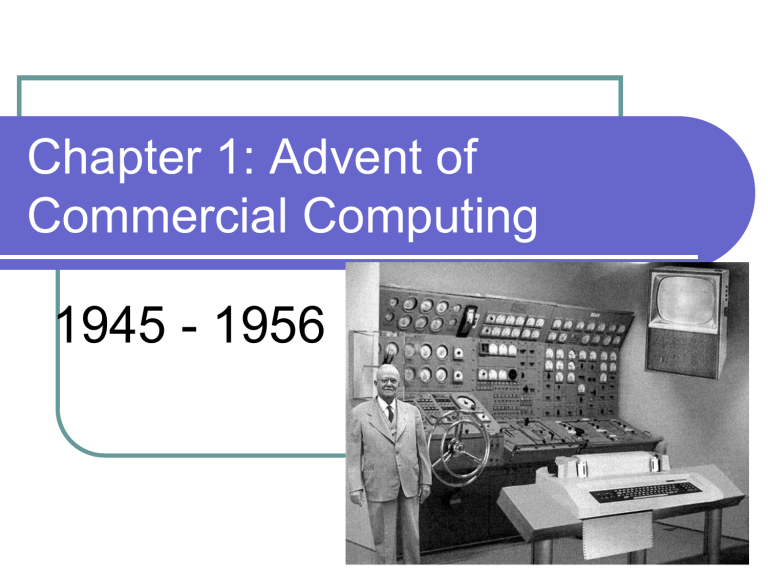
Chapter 1: Advent of
Commercial Computing
1945 - 1956
1
Univac Advertisement - 1955
“You… fellows ought to go back and change your program entirely, stop this… foolishness with
Eckert & Mauchley”
- Howard Aiken, 1948
* Historical Note: there were no computer scientists
2
Hollerith to IBM
1880 – US Census Bureau
1890 – Tabulating Machines
Tabulating Machines Co.
International Business Machines
Unit record equipment
Decks of punch cards
Basis of IBM’s success
3
Punch Card Systems
Same operation on each record of deck
Not well suited for scientific applications
1930’s – Some scientific users
IBM – through the 1950’s
Sold thousands of pc systems
Card Programmed Calculator (CPC)
Variety of new components
4
Card Controlled Calculator
Northrop Aircraft, CA
Attached printer to punch card machines
Attached cables
IBM marketed new set-up
Transition to electronic computers
5
Punch Card Equipment
6
ENIAC
J. Presper Eckert & John Mauchley
U. of PA Moore School of EE
Firing tables of US Army
18,000 vacuum tubes
Pressure to complete
1949
Programming (set up)
Plug Cables
Set Switches
7
ENIAC
Move to Aberdeen delayed due to demand for use
1948 – fully booked for 2 years
But…already had better ideas
Stored program to eliminate plugs & switches
8
First College Computer Course
Summer 1946
Moore School of Engineering @ U of PA with U. S. Military
Theory & Techniques for Design of
Electronic Digital Computers
Result of the staff’s inability to accommodate requests for information after unveiling of the ENIAC
9
Howard Aiken
Harvard mathematician
MARK I Calculator
“You fellows ought to go back and change your program entirely, stop this foolishness with Mauchley &
Eckert.”
US need for only 5 or 6 such machines
10
EDVAC
Electronic Discrete Variable Computer
“An important feature of this device was that operating instructions and function tables would be stored exactly in the same sort of memory device as that used for numbers.”
6 months later – Mauchley & Eckert left to form UNIVAC (stored program computer)
11
John von Neumann
Chance Meeting with Herman Goldstine
“First Draft of a report on EDVAC”
June 30 th , 1945
Von Neumann Architecture
Instruction and data in same memory device
*Summer 1946- Moore School - 1 st course
“Theory & Techniques for Design of Electronic
Digital Computers”
12
Eckert Mauchley Computer Corp.
Left PA March 31, 1946
(patent disagreement)
Incorporated in Dec. 1948
*DETAILS IN VIDEO*
Bought by Remington-Rand
1 st UNIVAC - US Census Bureau
March 31 st , 1951
#2 Pentagon: USAF June 1952
See Table on Pg. 28 for installations
13
UNIVAC Features
One Memory for data & Instructions
(1000 words)
Binary Coded Decimal
Clock Speed 2.25 MHz
465 Multiplications/ Second
Mercury Tubes and Magnetic Tape (no cards)
Excessive Redundancy – reliability
Alphanumeric Processing
Check Bits & Buffers
Output – high speed line printer
(1954)
14
UNIVAC 1 – Central Computer
15
UNIVAC – The First Users
(p.26)
*Revolutionary: tape replaced punch cards
Too late for 1950 Census; some state work
USAF & Atomic Energy Commission
Pentagon- Project SCOOP
Scientific Computation of Optimum Problems-
Linear programming discovered
1952- Presidential Election
UNIVAC became generic
G.E: 1 st Payroll Oct. 15, 1954
16
IBM
Still selling punch card machines
May 1952 - IBM 701- 2000 mult/sec (4x UNIVAC)
Hired Von Neumann as consultant
1 st 701 - IBM Headquarters, NY, Dec. 1952
2 nd Los Alamos Nuclear Weapons Lab, ’53
19 Built- US Def. Dept or military aerospace firms
Rent Only: $15,000 a month
September ’53 -702 - built 14
17
Punch Card Computer System
Railroad Computer 1967
18
Engineering Research Associates
Spun off from NAVY - codebreakers
Seymour Cray, William Norris
Task 13 – general purpose electronic computer, 1947 to 1951
Atlas for NAVY; Model 1101 for public-20
Bought by Remington Rand
1103 - 1 st core memory (not tubes), binary arithmetic, “interrupt”
19
Magnetic Drum
Late 1930’s –John V. Atanasoff
ERA developed; 4.3 to 34 inch diameter
Inexpensive but slow
Number of inexpensive Computers in 1950’s
Computer Research Corp., CA
Bought by National Cash Register
Labrascope/General Precision
400@ $30,000, one of cheapest ever
Small, affordable
Univac Drum
20
Magnetic Drum (contd)
Bendix – Turing vs. von Neumann design
Minimum latency coding for drum (Turing)
400 @ $45,000
Fast but difficult to program
Bought by Control Data Corp.
Mag Drum 1961
IBM 650, 1954
(modest computer)
1000@ $3,500 per month
Universities 60% discount
If promised to teach courses
21
Summary
First Generation of Computer
Cards, Tubes, Tapes, Drums, Diodes…
Numerous start-ups bought out
IBM & Others quite successful
22


